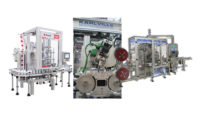PMMI Corner
Cannabis Packaging is Growing Like a Weed

Despite being surrounded in controversy, the U.S. cannabis industry is experiencing rapid growth. Experts estimate legal cannabis will grow from $7.3 billion to $24.5 billion between 2016 and 2020. Currently, 65 percent of cannabis sales stem from medical marijuana, which is legalized to various degrees in 29 states with legislation pending in 15 more, according to the “Here to Stay or Up in Smoke? A Look at the U.S. Cannabis Market” white paper from PMMI, The Association for Packaging and Processing Technologies.
With a product that is quasi-legal, the industry faces many uncertainties regarding its future direction. But, the upside of this growing business seems to be worth the risk, and many cannabis producers are rising to the task of balancing strict regulations, rising consumer demand and shifting market landscapes.
Segmented into three broad categories—flowers, concentrates and edibles—each cannabis product type has unique packaging needs. Gone are the days of the clear plastic dime bag with the ink-jet printed label filled with dried cannabis flower. Cannabis flower products are now packaged in airtight, odor-proof resealable glass jars, Pyrex tube jars or resealable, smell-proof bags that are heat-sealed, making them tamper evident.
Cannabis concentrates come in heat-proof borosilicate glass containers that allow product liquefaction without breakage. Polystyrene containers or acrylic containers that are BPA-free and offer a premium look can also package these concentrates.
Cannabis edibles are the fastest growing cannabis products ranging from bakery products to sodas and teas. Packaging formats include tube jars that can be sealed with shrink bands to protect product integrity, single-use bags using food-grade films and resealable smell-proof bags that can be heat sealed.
Cannabis packaging is highly regulated and varies by state, but some of the most common requirements are child-proofing/child resistance, resealable, tamper-evident and opaque. Many states also require single-use packaging for products even when sold in bulk, such as vape cartridges. Some states require cannabis to be vertically integrated, meaning they must grow and package at the same facility. The variability in packaging rules and designs makes it difficult to develop a one-size-fits-all package for use in multiple states.
As the industry grows and competition increases, producers seek high-end packaging options to help differentiate brands and attract older, more affluent consumers. One challenge these manufacturers face is that branding efforts are often undermined by not being able to trademark their brand—the U.S. Trademark Office denies trademark protection to brands selling cannabis, making it difficult to establish brand identity.
To find out more about solutions for cannabis packaging, come to PACK EXPO International and the co-located Healthcare Packaging EXPO (Oct. 14-17, 2018; McCormick Place, Chicago). More than 50,000 attendees will convene on the newest machinery, materials and container solutions displayed by over 2,500 exhibitors. The Containers and Materials Pavilion, and The Reusable Packaging Pavilion will display advances in package design and sustainable packaging. The Showcase of Packaging Innovations will have award-winning packages on display. Free 30-minute seminars focused on new and innovative technologies presented by the experts, will be throughout the show on the Innovation Stage. New this year, The PACKage Printing Pavilion will offer an opportunity to see the latest labeling and digital printing innovations and techniques.
To register and learn more, visit packexpointernational.com.
Looking for a reprint of this article?
From high-res PDFs to custom plaques, order your copy today!







